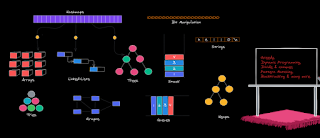A tree is a sort of data structure used in computer
science and data structures that simulates a natural tree's hierarchical
structure. Except for the root node, which has no parent node, it consists of
nodes connected by edges, each of which may have zero or more child nodes. Each
node in a tree has a value and could also have references to the nodes below
it.
Data structures that can represent data items with a hierarchical relationship between their parents, descendants, and so on include trees, which are particularly adaptable, versatile, and durable. In a tree, each node can have 0–no child nodes, each of which can have its offspring. A common motif in computer science is trees. and programming for effectively sorting, searching, and organizing data.
A non-linear data structure called a tree is used to organize things or elements in sorted order. It is utilized to symbolize a hierarchical relationship between various data components. Except for the root node, which has no parent node, every node in a tree can have zero or more child nodes. In computer science and programming, trees are frequently used for effective data searching, sorting, and organization.
A chart A tree is theoretically defined as One or more
data contained in a finite set. The ROOT of the tree is a specific data object.
The remaining data items are divided into several
mutually exclusive subsets, each of which is a tree; these subsets are referred
to as SUBTREES.
Tree data
structures types
General tree
Binary tree
Binary search tree
AVL tree
Red-black tree
1. General Tree
2.
Binary Tree
The following characteristics of a binary tree are
characteristics of a data structure.
Properties
Observe a tree's characteristics.
There are a maximum of two children per node.
The left and right child nodes of this pair are referred to as such.
Usage
They are built by compilers using syntax trees.
This class is utilized to implement expression parsers and solvers.
In this are stored router tables.
3.
Binary Search Tree
4.
AVL tree
An AVL tree is a self-balancing binary search tree. The first tree whose height is automatically balanced is this one.
Properties
It is recommended to adhere to the properties of binary search trees.
Self-balancing.
A statistic known as a balancing factor, which represents the height difference between a node's left and right subtrees, is kept track of by each node.
All nodes must have a balancing factor of -1, 0, or 1.
Rotations should be carried out to balance the tree following insertions or deletions (self-balancing) if at least one node does not have a balance factor of -1, 0, or 1.
Usage
This is the best approach to take when there are numerous insertions.
It is employed in the Memory management subsystem of the Linux kernel to examine memory regions of processes during preemption.
5.
Red-black tree
A self-balancing binary search tree called a red-black tree has each leaf being The node colors are used to keep the tree relatively balanced throughout insertions and deletions.
Properties
It is recommended to adhere to the properties of binary search trees.
Self-balancing.
Each node is either red or black.
The root is usually omitted and is black.
The leaves (labeled NIL) are all entirely black.
If a node is red, both of its offspring are black.
There must always be an equal number of black nodes between each node and each of its child nodes.
Usage
as a base for data structures for computational geometry.
It is utilized by the Completely Fair Scheduler in contemporary Linux kernels.
utilized in the poll system call implementation in the Linux kernel.
Conclusion
You must first master the fundamentals of tree data
structure, including what a tree is, where you may use it, and its
characteristics. You can consult Narasimha Karumanchi's Data Structure and
Algorithm Made Easy for that. You can then go on to the issue set. You'll gain
a lot of clarity on the subject via practice.
Additionally, Tutort Academy is the best place where
you can learn about it and its real life additionally the academy provides System
design courses , DSA
courses, Artificial intelligence etc.





